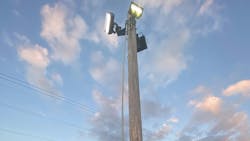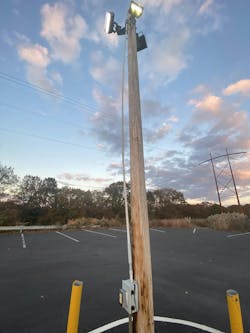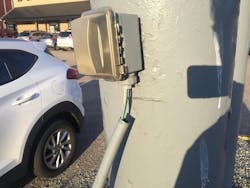All references are based on the 2023 edition of the NEC.
Clipless Conduit
I don’t know how it happened, but every clip that was installed to secure this rigid PVC conduit is gone. Only small remnants of each clip remain attached to this pole. Perhaps the clips were not sunlight resistant as required by Sec. 300.6(C)(1) and disintegrated from long term exposure to the sun. Unfortunately, I have seen that happen in several installations.
Table 352.30(B) requires ¾-in. rigid PVC conduit to be supported at intervals no greater than 3 ft. This conduit run may have complied with that requirement when it was originally installed, but it most certainly does not comply now — leading to a big bow in the conduit. On a more positive note, the installer did include an expansion coupling in the PVC conduit run as required by Sec. 352.44(A).
One other problem I spotted with this installation was the lack of a cover for the receptacle installed in the box near the bottom of the pole. Section 406.9(B)(1) requires 15A and 20A, 125V and 250V receptacles to be installed in enclosures that are weatherproof whether or not an attachment plug cap is plugged in. This enclosure is wide open to wind, rain, snow, and all the elements Mother Nature can throw at it.
Limp Liquidtight Conduit
This liquidtight flexible nonmetallic conduit (LFNC) has pulled out of the connector, leaving the conductors exposed to sun, rain, and all kinds of other potentially damaging forces. The separated conduit can also allow water to enter directly into the raceway. In winter, this water could freeze, expand, and cause severe damage to the raceway, potentially splitting it open. Section 356.30 provides several different requirements for securing and supporting LFNC. This installation complies with none of them. Section 300.11(A) requires raceways to be securely fastened in place.
Section 300.12 requires raceways to be continuous between boxes, conduit bodies, other enclosures, fittings, and outlets. This installation violates this requirement. Section 310.10(D) requires conductors exposed to direct sunlight to be listed as being sunlight resistant or be covered with an insulating sleeve or tape that is listed as being sunlight resistant. The THWN-2 conductors used here are rated for use in wet locations, but its insulation is not sunlight resistant. If not repaired, the insulation will eventually break down. On a positive note, the “bubble cover” installed on the switch box provides a weatherproof enclosure as required by Sec. 404.4(A).
About the Author

Russ LeBlanc
Owner
Russ started in the electrical trade as an apprentice in 1985. He worked his way up to become a Journeyman Electrician and then eventually became a Master Electrician and Licensed Construction Supervisor. In 1999 Russ become an Electrical Instructor for The Peterson School of Engineering in Massachusetts where he developed his passion for teaching, and quickly became Department Head of Electrical Instruction. Russ has taught thousands of apprentices, electricians, engineers, inspectors, and other electrical professionals during his career as an instructor. He continues to provide electrical professionals with Electrical Code seminars, Arc-Flash Awareness training seminars and educational material through his LeBlanc Consulting Services in North Reading, MA whose specialty is educating electricians. He has been an active member of the NFPA Electrical Section and has authored hundreds of National Electrical Code proposals and comments which have become Code rules to improve the safety for the electrical industry. Russ is also an IAEI certified Electrical Inspector.
Please visit www.russleblanc.net for more information.


